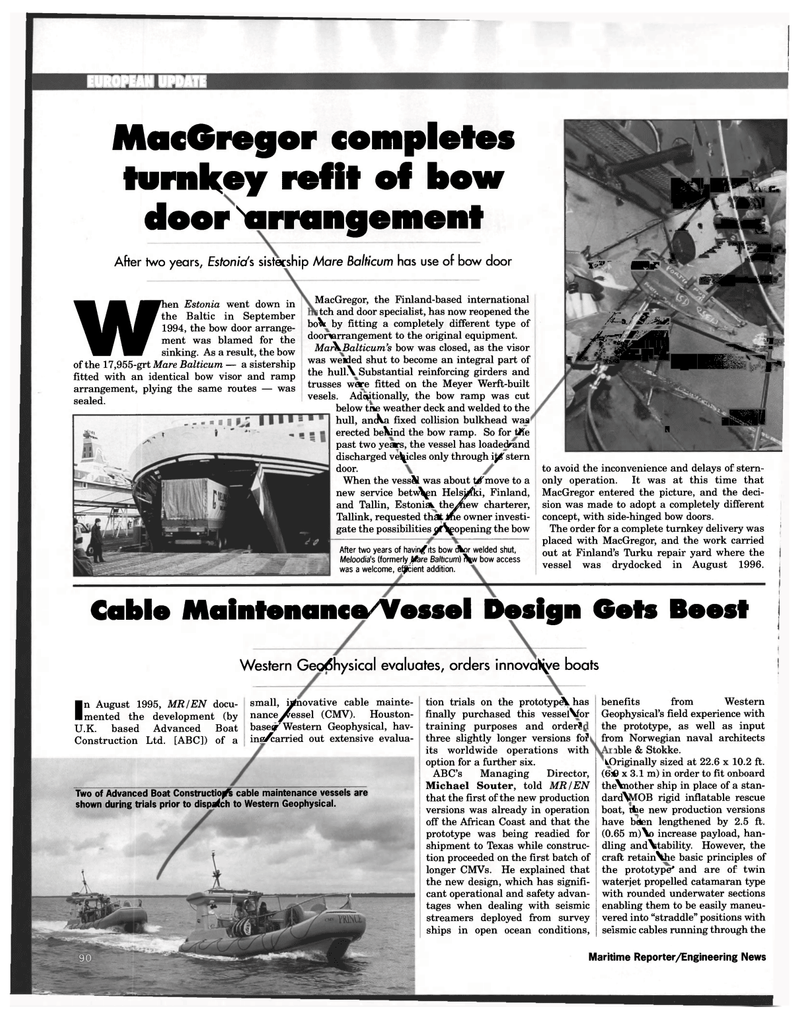
Page 90: of Maritime Reporter Magazine (February 1997)
Read this page in Pdf, Flash or Html5 edition of February 1997 Maritime Reporter Magazine
EUROPEAN UPDATE
MacGregor completes turnkey refit of bow door'arrangement
After two years, Estonia's sistership Mare Balticum has use of bow door
When Estonia went down in the Baltic in September 1994, the bow door arrange-ment was blamed for the sinking. As a result, the bow of the 17,955-grt Mare Balticum — a sistership fitted with an identical bow visor and ramp arrangement, plying the same routes — was sealed.
MacGregor, the Finland-based international tch and door specialist, has now reopened the bo\ by fitting a completely different type of doonarrangement to the original equipment.
Mai^Balticum's bow was closed, as the visor was welded shut to become an integral part of the hull.X Substantial reinforcing girders and trusses ware fitted on the Meyer Werft-built vesels. Additionally, the bow ramp was cut below tre weather deck and welded to the hull, anctai fixed collision bulkhead was erected beVnd the bow ramp. So for tile past two years, the vessel has loadedrand discharged vehicles only through i^f stern door.
When the vessSi was about tif move to a new service betw^n Hels^ki, Finland, and Tallin, Estonian thf^iew charterer,
Tallink, requested thatifie owner investi- gate the possibilities yfVgopening the bow
After two years of havin^its bow ctar welded shut,
Me/ood/a's (formerly Ufare Balticum) \w bow access was a welcome, efficient addition. llliS t ^Yvads* ^^S^A to \
I y iBLfll^ \ ' jT -jr • \ Met*. y. isMf'
Jr x /—3 & J? i .^^hsaW- -'
JL- —rr M i / ' -gsM § / / JH® # Mgm ^^^ H t / a. | AHr^j.R IIR V Jr^ \ II
N to avoid the inconvenience and delays of stern- only operation. It was at this time that
MacGregor entered the picture, and the deci- sion was made to adopt a completely different concept, with side-hinged bow doors.
The order for a complete turnkey delivery was placed with MacGregor, and the work carried out at Finland's Turku repair yard where the vessel was drydocked in August 1996.
Cable Maintenance Vessel Design Gets Beest eQ6hysical evaluates, orders innovate boats Western G small, innovative cable mainte- nance ^essel (CMV). Houston- basetf Western Geophysical, hav- inaX:arried out extensive evalua- tion trials on the prototyp^V has finally purchased this vesseiVor training purposes and order? three slightly longer versions fof its worldwide operations with option for a further six.
ABC's Managing Director,
Michael Souter, told MR/EN that the first of the new production versions was already in operation off the African Coast and that the prototype was being readied for shipment to Texas while construc- tion proceeded on the first batch of longer CMVs. He explained that the new design, which has signifi- cant operational and safety advan- tages when dealing with seismic streamers deployed from survey ships in open ocean conditions, benefits from Western
Geophysical's field experience with the prototype, as well as input from Norwegian naval architects ible & Stokke. tf)riginally sized at 22.6 x 10.2 ft. (6j6 x 3.1 m) in order to fit onboard theViother ship in place of a stan- dard\MOB rigid inflatable rescue boat, rte new production versions have beten lengthened by 2.5 ft. (0.65 m)V) increase payload, han- dling andVtability. However, the craft retainVie basic principles of the prototype' and are of twin waterjet propelled catamaran type with rounded underwater sections enabling them to be easily maneu- vered into "straddle" positions with seismic cables running through the
Maritime Reporter/Engineering News
Two of Advanced Boat Construction cable maintenance vessels are shown during trials prior to dispatch to Western Geophysical.
In August 1995, MR I EN docu-mented the development (by
U.K. based Advanced Boat
Construction Ltd. [ABC]) of a

 89
89

 91
91
